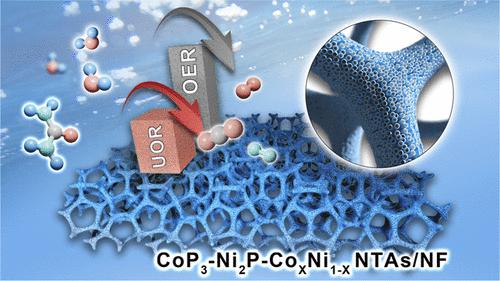当前位置:
X-MOL 学术
›
ACS Sustain. Chem. Eng.
›
论文详情
Our official English website, www.x-mol.net, welcomes your
feedback! (Note: you will need to create a separate account there.)
Enhancing Alloyed Nickel Sites via Heterogeneous CoP3–Ni2P Modification for Highly Efficient Urea Electrooxidation
ACS Sustainable Chemistry & Engineering ( IF 7.1 ) Pub Date : 2024-11-11 , DOI: 10.1021/acssuschemeng.4c06637 Li-Li Zhang, Wenya Li, Mingming Yin, Chenchen Cui, Wei Ma, Zhen Zhou
ACS Sustainable Chemistry & Engineering ( IF 7.1 ) Pub Date : 2024-11-11 , DOI: 10.1021/acssuschemeng.4c06637 Li-Li Zhang, Wenya Li, Mingming Yin, Chenchen Cui, Wei Ma, Zhen Zhou

|
To align with the high-energy conversion efficiency in the electrochemical synthesis of hydrogen carriers, it is pivotal to boost the reaction kinetics of the anode in the electrolytic cell. Electrocatalytic urea oxidation reaction (UOR) has gained attention as a promising alternative anode reaction to water oxidation due to its small theoretical oxidation potential. However, the application of UOR is confronted with great challenges due to the unsatisfactory current under a low potential. Herein, we developed a self-supported electrode, heterogeneous cobalt phosphide, and nickel phosphide-modified nickel–cobalt alloy nanotube arrays with nickel foam as skeleton support (CoP3–Ni2P–CoxNi1–x NTAs/NF) to improve the UOR performance by optimizing the local charge distribution of active Ni sites. The CoP3–Ni2P–CoxNi1–x NTAs/NF electrode exhibited excellent UOR activity with a low potential of 1.36 V (vs RHE) at 100 mA cm–2. Surface structure analysis and electrochemical in situ Raman results revealed that synchronous CoNi alloying and heterogeneous CoP3–Ni2P introduction boosted the formation of the active Ni3+–O species caused by the modulated surface electronic structure of Ni atoms, thus accelerating the interfacial electrocatalysis. This work presents a new option for template synthesis catalysts for efficient urea oxidation reactions.
中文翻译:

通过非均相 CoP3-Ni2P 改性增强合金镍位点以实现高效尿素电氧化
为了与氢载体电化学合成中的高能量转换效率保持一致,提高电解槽中阳极的反应动力学至关重要。电催化尿素氧化反应 (UOR) 由于其理论氧化电位小,作为一种很有前途的水氧化替代阳极反应而受到关注。然而,由于低电位下的电流不令人满意,UOR 的应用面临着巨大的挑战。在此,我们开发了一种自支撑电极、异相磷化钴和磷化镍改性镍钴合金纳米管阵列,以泡沫镍作为骨架支撑 (CoP3-Ni 2P-CoxNi 1-x NTAs/NF),通过优化活性 Ni 位点的局部电荷分布来提高 UOR 性能。CoP3-Ni 2P-CoxNi 1-x NTAs/NF 电极表现出优异的 UOR 活性,在 100 mA cm-2 处具有 1.36 V (vs RHE) 的低电位。表面结构分析和电化学原位拉曼结果表明,同步 CoNi 合金化和非均相 CoP3–Ni2P 引入促进了由 Ni 原子调制表面电子结构引起的活性 Ni3+–O 物种的形成,从而加速了界面电催化。本研究为模板合成催化剂提供了一种新的选择,用于高效的尿素氧化反应。
更新日期:2024-11-12
中文翻译:

通过非均相 CoP3-Ni2P 改性增强合金镍位点以实现高效尿素电氧化
为了与氢载体电化学合成中的高能量转换效率保持一致,提高电解槽中阳极的反应动力学至关重要。电催化尿素氧化反应 (UOR) 由于其理论氧化电位小,作为一种很有前途的水氧化替代阳极反应而受到关注。然而,由于低电位下的电流不令人满意,UOR 的应用面临着巨大的挑战。在此,我们开发了一种自支撑电极、异相磷化钴和磷化镍改性镍钴合金纳米管阵列,以泡沫镍作为骨架支撑 (CoP3-Ni 2P-CoxNi 1-x NTAs/NF),通过优化活性 Ni 位点的局部电荷分布来提高 UOR 性能。CoP3-Ni 2P-CoxNi 1-x NTAs/NF 电极表现出优异的 UOR 活性,在 100 mA cm-2 处具有 1.36 V (vs RHE) 的低电位。表面结构分析和电化学原位拉曼结果表明,同步 CoNi 合金化和非均相 CoP3–Ni2P 引入促进了由 Ni 原子调制表面电子结构引起的活性 Ni3+–O 物种的形成,从而加速了界面电催化。本研究为模板合成催化剂提供了一种新的选择,用于高效的尿素氧化反应。


















































 京公网安备 11010802027423号
京公网安备 11010802027423号